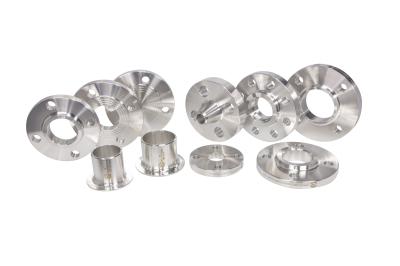Key aspects of stainless steel flanges
2023-10-16
Stainless steel flanges are components used in piping systems to connect pipes, valves, pumps, and other equipment. They play a crucial role in providing a secure, leak-proof, and easily maintainable connection between different parts of a piping system. Stainless steel is a popular material choice for flanges due to its corrosion resistance, durability, and strength, making it suitable for various industrial applications. Here are some key aspects of stainless steel flanges:
1. Materials:
- Stainless steel flanges are typically made from stainless steel alloys, which contain a minimum of 10.5% chromium. Common stainless steel grades used for flanges include 304, 316, 321, 347, and 310, among others. The choice of grade depends on factors like the application's temperature and corrosive environment.
2. Types of Flanges:
- There are several types of stainless steel flanges, each designed for specific purposes:
- Weld Neck Flanges
- Slip-On Flanges
- Socket Weld Flanges
- Threaded Flanges
- Lap Joint Flanges
- Blind Flanges
- Orifice Flanges
- Spectacle Blind Flanges
- Expander Flanges
- Reducing Flanges
- Swivel Flanges
- Companion Flanges (used with stub ends)
- The choice of flange type depends on factors like pipe size, pressure, temperature, and the method of joining required.
3. Flange Face Types:
- Flanges have different face types, including flat face (FF), raised face (RF), and ring-type joint (RTJ). The face type affects the sealing mechanism and gasket selection.
4. Pressure Ratings:
- Stainless steel flanges come with specific pressure ratings, such as ANSI/ASME 150, 300, 600, 900, 1500, and 2500. The pressure rating indicates the maximum pressure the flange can safely handle at a given temperature.
5. Flange Standards:
- Flanges are manufactured to various industry standards, such as ANSI/ASME, API, DIN, EN, and JIS, among others. These standards define the flange dimensions, materials, and performance requirements.
6. Applications:
- Stainless steel flanges find use in a wide range of industries, including oil and gas, petrochemical, chemical processing, food and beverage, pharmaceuticals, water treatment, and more. They are employed in piping systems to facilitate connections, maintenance, and modifications.
7. Installation:
- Proper installation is essential to ensure flange connections are leak-proof and reliable. This includes using the correct gaskets, bolting procedures, and torque specifications.
8. Corrosion Resistance:
- Stainless steel's corrosion resistance is a significant advantage, particularly in environments where exposure to moisture, chemicals, or aggressive substances is a concern. It helps prevent rust and degradation.
9. Maintenance:
- Regular inspection and maintenance of stainless steel flanges are necessary to ensure their continued performance and prevent issues like gasket leaks or bolt loosening.
Stainless steel flanges are critical components in various industrial processes, and their selection should take into account factors like material compatibility, pressure and temperature requirements, and adherence to industry standards. Proper installation and maintenance are crucial to the long-term performance and safety of flanged connections.



